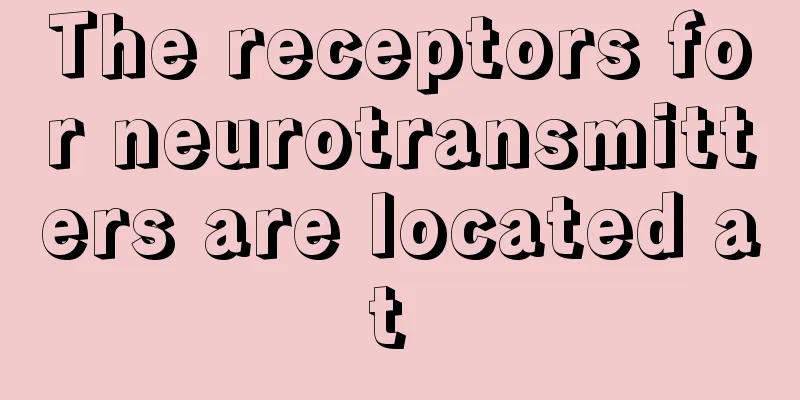The receptors for neurotransmitters are located at

|
Neurotransmitter is a substance located in neurons and is also a substance that is of great significance to the human body's sensory nerves. Neurotransmitter receptors also have a certain influence on neurotransmitters. This substance is generally located outside the cell, across the membrane or in the cytoplasm. The neurotransmitter receptors in different locations have different functions. The neurotransmitter receptors will be introduced in detail below! 1. What are neurotransmitter receptors? Receptors coupled to second messengers are usually monomeric structures with three components: the extracellular part, which is the site of glycosylation; the transmembrane part, which is bag-shaped and generally believed to be the site where neurotransmitters act; and the intracytoplasmic part, which is where G proteins bind or phosphorylate to regulate the receptors. Ion channel receptors are all complex structures. In certain instances, activation of the receptor causes a change in ion channel permeability. In other cases, activation of second messengers causes changes in channel conductance. 2. Life Cycle In the central nervous system (CNS), the most important mode of synaptic transmission is neurochemical transmission. After being released from the presynaptic membrane, neurotransmitters immediately bind to the corresponding postsynaptic membrane receptors, generating a synaptic depolarization potential or hyperpolarization potential, resulting in an increase or decrease in the excitability of the postsynaptic nerve. The action of neurotransmitters can be terminated through two pathways: one is recycling inhibition, that is, the excess neurotransmitters in the synaptic cleft are recycled to the presynaptic neuron through the action of presynaptic carriers and stored in vesicles; the other pathway is enzymatic hydrolysis. Taking dopamine (DA) as an example, it is metabolized and inactivated through the action of monoamine oxidase (MAO) located in the mitochondria and catecholamine o-methyltransferase (COMT) located in the cytoplasm. 3. Standards Neurotransmitters must meet the following criteria: ① Synthesized within neurons. ②. Amount stored in synaptic neurons and released at a certain concentration (with significant physiological effects) when polarized. ③. When used as a drug, the exogenous molecule resembles endogenous neurotransmitters. ④. The mechanism of neurons or synaptic clefts is the clearance or inactivation of neurotransmitters. If all criteria are not met, it is called a "proposed neurotransmitter". |
<<: What shampoo to use for oily and itchy hair
>>: What is the Difference Between Tympanic Drum and Eardrum?
Recommend
How can lung cancer patients determine whether metastasis has occurred? You can determine it from the following aspects
Lung cancer is a disease that is easy to metastas...
There are white horizontal lines on toenails
Toenails are a very small part of the human body,...
What should I do if I have pollen allergy and asthma
Pollen allergy asthma has a relatively large impa...
The difference between Pu'er tea and black tea
In China, drinking tea is a tradition from ancien...
The dangers of inverted heart t wave
The heart can be said to be the most important or...
There is a raised hard lump on my hand
There is a raised hard lump on the hand. This phe...
Will liver cancer cause shoulder pain? Generally not
Liver cancer is one of the most common malignant ...
How long can you live after skin cancer surgery?
How long can you live with skin cancer? Skin canc...
How long can purple sweet potatoes be kept
Although purple sweet potatoes are not as sweet a...
What do polarized glasses mean?
Most of the glasses we wear in our daily lives ar...
What are the drugs for liver cancer
Liver cancer is a frightening disease, but the de...
What foods should breast cancer patients avoid?
Breast cancer patients should avoid eating spicy ...
What is early screening for lung cancer? You can do these three tests
If you want to determine whether a person has dev...
How did the leg get broken
Bones are an important part of the human body. If...
Elderly patients will have obvious loss of appetite, which is an early symptom of gastric cancer
Although people's living standards have impro...









